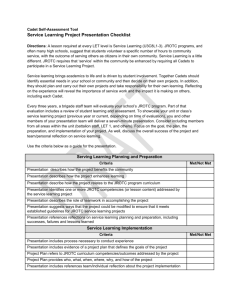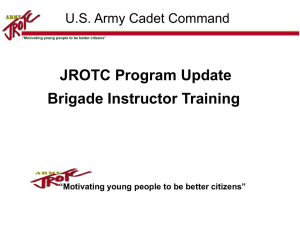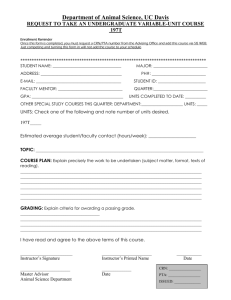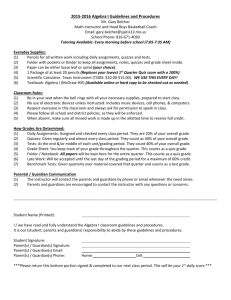LE-III/IV Class Syllabus - Springboro Community Schools
advertisement
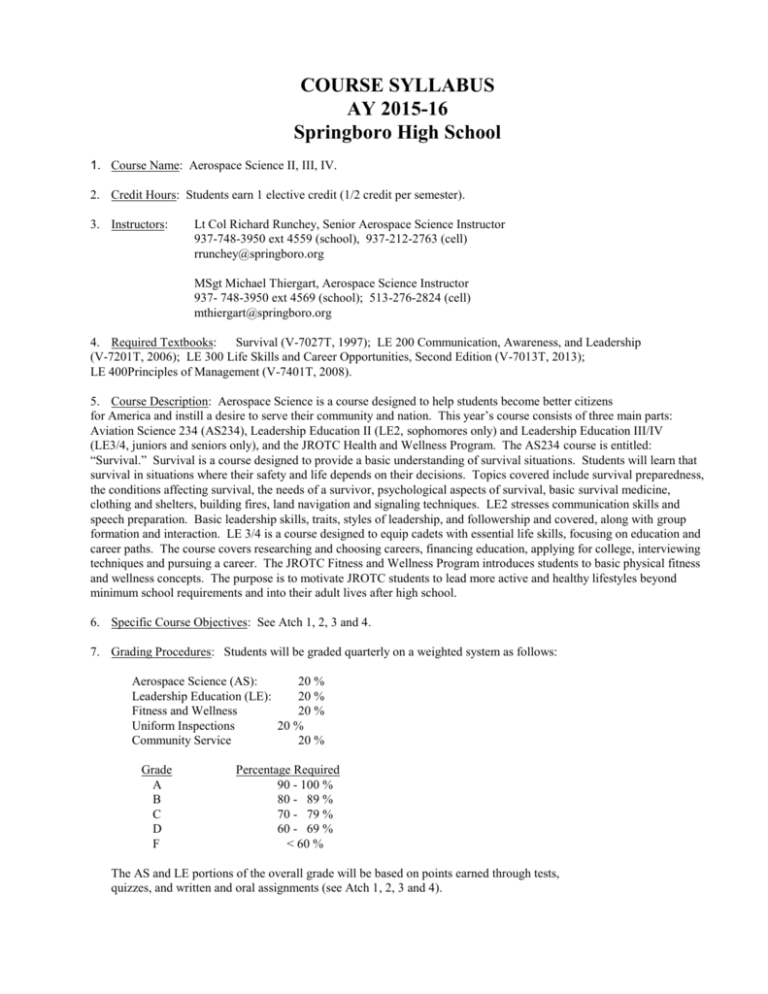
COURSE SYLLABUS AY 2015-16 Springboro High School 1. Course Name: Aerospace Science II, III, IV. 2. Credit Hours: Students earn 1 elective credit (1/2 credit per semester). 3. Instructors: Lt Col Richard Runchey, Senior Aerospace Science Instructor 937-748-3950 ext 4559 (school), 937-212-2763 (cell) rrunchey@springboro.org MSgt Michael Thiergart, Aerospace Science Instructor 937- 748-3950 ext 4569 (school); 513-276-2824 (cell) mthiergart@springboro.org 4. Required Textbooks: Survival (V-7027T, 1997); LE 200 Communication, Awareness, and Leadership (V-7201T, 2006); LE 300 Life Skills and Career Opportunities, Second Edition (V-7013T, 2013); LE 400Principles of Management (V-7401T, 2008). 5. Course Description: Aerospace Science is a course designed to help students become better citizens for America and instill a desire to serve their community and nation. This year’s course consists of three main parts: Aviation Science 234 (AS234), Leadership Education II (LE2, sophomores only) and Leadership Education III/IV (LE3/4, juniors and seniors only), and the JROTC Health and Wellness Program. The AS234 course is entitled: “Survival.” Survival is a course designed to provide a basic understanding of survival situations. Students will learn that survival in situations where their safety and life depends on their decisions. Topics covered include survival preparedness, the conditions affecting survival, the needs of a survivor, psychological aspects of survival, basic survival medicine, clothing and shelters, building fires, land navigation and signaling techniques. LE2 stresses communication skills and speech preparation. Basic leadership skills, traits, styles of leadership, and followership and covered, along with group formation and interaction. LE 3/4 is a course designed to equip cadets with essential life skills, focusing on education and career paths. The course covers researching and choosing careers, financing education, applying for college, interviewing techniques and pursuing a career. The JROTC Fitness and Wellness Program introduces students to basic physical fitness and wellness concepts. The purpose is to motivate JROTC students to lead more active and healthy lifestyles beyond minimum school requirements and into their adult lives after high school. 6. Specific Course Objectives: See Atch 1, 2, 3 and 4. 7. Grading Procedures: Students will be graded quarterly on a weighted system as follows: Aerospace Science (AS): 20 % Leadership Education (LE): 20 % Fitness and Wellness 20 % Uniform Inspections 20 % Community Service 20 % Grade A B C D F Percentage Required 90 - 100 % 80 - 89 % 70 - 79 % 60 - 69 % < 60 % The AS and LE portions of the overall grade will be based on points earned through tests, quizzes, and written and oral assignments (see Atch 1, 2, 3 and 4). Uniform Inspections. Students are required to wear the uniform once each week (typically each Wednesday), will be formally inspected in class, and must wear the uniform a minimum number of times during school each quarter. Failure to wear the uniform may result in one or more of the following: reduced or failing grade for the week/quarter/semester; suspension/dismissal from the JROTC Drill Team; not being allowed to attend JROTC functions; not being considered for promotion or possible demotion; removal from assigned JROTC leadership position; removal from the JROTC program. The parent/guardian will be contacted if a pattern of failure regarding the uniform is observed and intervention is required to help the student meet standards. Cadets must meet proper grooming standards (e.g., haircuts, facial hair, earrings, nail polish, etc) and their weekly inspections will count for 20% of their overall grade in JROTC each quarter. Cadets who have not yet received their uniform will not be inspected each week (in Progress Book, the inspection grades for these cadets will be excluded and not affect their overall JROTC grade for the term). For more detailed information on uniform standards and weekly inspections, refer to the 2015-16 Cadet Guide and Uniform Wear Standards memorandum each cadet received during the first week of school, the 2015-16 Cadet Guide, and the Air Force JROTC Operational Supplement dated 1 Aug 2015. Fitness and Wellness. Each Friday, JROTC instructors will supervise cadets in fitness-related activities. Students will be graded on their attendance, participation and effort. About 25 percent of the Fitness and Wellness grade will also be based on the student’s fitness level and improvement in overall fitness scores during the academic year. Points will be deducted for tardiness, negative conduct (e.g., lack of effort, disruptive behavior, etc), or inability to participate due to illness/injury/absence. Students who are unable to participate on a given fitness day will be required to perform aerobic make-ups out of school as directed by the JROTC instructors. Upon completion of the make-up form, the student will obtain a parent/guardian signature and return the form to the JROTC instructors. Students are allowed to make-up only one unexcused absence each quarter. Additional unexcused absences will result in zero points for that day of absence. Community Service. One of our primary mission objectives of JROTC is to instill in each student a desire to serve the JROTC corps, the school, the community and our nation. Every cadet is expected to volunteer some of their time to community service which includes such things as color guards, flag ceremonies, assisting veterans groups, schoolrelated service activities, as well as other general forms of community service (food bank, nursing homes, public library, etc). Our cadet corps will typically provide over 3000 hours of community service each year, by far the highest total of any student organization at SHS. We take great pride in our community service program. Cadets are required to complete 5 hours of community service each quarter. Cadets will earn 50 points for each hour of community service, up to a maximum of 250 points per quarter. Cadets must gain SASI or ASI approval of nonJROTC related community service prior to completing the service event. Extra Credit: Students can earn up to 10 additional percentage points added to their overall quarter grade in JROTC by completing extra hours of community service during the quarter. Students can earn an additional 5 percent extra credit on their quarter grade for completing 6 hours and 10 percent extra credit for competing 7 hours during the quarter. Classroom Conduct: Classroom rules are posted on the bulletin board at the rear of the room. Students are also expected to adhere to all rules outlined in the Springboro Student Handbook, the JROTC Cadet Guide, and any additional requirements provided by the JROTC instructors. RICHARD C. RUNCHEY, Lt Col, USAF (ret) Senior Aerospace Science Instructor MICHAEL P. THIERGART, MSgt, USAF (ret) Aerospace Science Instructor ATTACHMENT 1 Course Syllabus AS II/III/IV Survival 1. Overview: Survival is a course designed to provide a basic understanding of survival situations. Students will learn that survival in situations where their safety and life depends on their decisions. Topics covered include survival preparedness, the conditions affecting survival, the needs of a survivor, psychological aspects of survival, basic survival medicine, clothing and shelters, building fires, land navigation and signaling techniques. 2. Instructor: Lt Col Rich Runchey, Senior Aerospace Science Instructor 937-748-3950 ext 4559 (school); 937-212-2763 (cell) rrunchey@springboro.org 3. Specific Course Objectives: See attached 4. Grading Procedures: AS Survival counts for 20 percent of the student’s overall JROTC grade each quarter. A student's AS grade will be based on total points earned through tests, quizzes, workbook assignments, worksheets, and possibly oral and written assignments. The total number of points per quarter is usually up to 300 points, depending on how the class progresses during the quarter. Tests are given at the end of each major chapter section, range from 50 to 100 points each, and comprise about half of the total points during the quarter. Quizzes are typically 10 to 20 points each and comprise about 20 percent of the total points, and other assignments comprise about 30 percent of the total points. 5. Grading Scale: Grade A B C D F Percentage Required 90 - 100 % 80 - 89 % 70 - 79 % 60 - 69 % < 60 % RICHARD C. RUNCHEY, Lt Col, USAF (ret) Senior Aerospace Science Instructor Survival -- Critical Objectives Chapter 1-1: Survival Preparedness Know how to survive in situations where your safety and life depends on your decisions. Chapter 1-2: Conditions Affecting Survival Know the three basic conditions affecting survival. Chapter 1-3: The Survivor’s Needs Know the two fundamental goals of a survivor are maintaining life and returning. Chapter 1-4: Psychological Aspects of Survival Know that coping with the psychological aspects of survival is a key ingredient in any survival situation. Chapter 1-5: The Will to Survive Know the importance of having the will to survive in hopeless situations. Chapter 2-1: Basic Survival Medicine Know basic survival medicine procedures, treatments, and prevention measures when faced with medical encounters. Chapter 2-3: Proper Body Temperature Know the proper body temperature. Chapter 2-4: Clothing Know that clothing is an important asset to survivors. Chapter 2-5: Shelters Know how the environment influences shelter sites and factors to consider before constructing the shelter. Chapter 3-1: Firecraft Know how to build, design, and light a fire when in a survival situation. Chapter 3-2: Equipment Know how to care and use issued equipment, and improvise when the needed equipment is not available. Chapter 3-3: Food Know that a survivor must meet his body needs through the intake of food. Chapter 3-5: Water Know how to locate, procure, purify, and store water. Chapter 4-1: Land Navigation Know how to use a map and compass. Chapter 4-3: Land Travel Know if land travel is or is not a necessity in a survival situation. Chapter 4-4: Signaling Techniques Know how survivors can assist in their own recovery with signaling techniques. ATTACHMENT 2 Course Syllabus Leadership Education II – Intercommunicative Skills 1. Overview: Leadership Education 2 (LE2) is a course designed to stress communication skills and speech preparation. Basic leadership skills, traits, styles of leadership, and followership are covered, along with group formation and interaction. 2. Instructor: MSgt Michael Thiergart, Aerospace Science Instructor 937- 748-3950 ext 4569 (school); 513-276-2824 (cell) mthiergart@springboro.org 3. Specific Course Objectives: See attached 4. Grading: A student's LE grade will be based on total points earned through tests, quizzes, workbook assignments, and oral and written Research Project. The total number of points per quarter is usually from 200 to 300 points, depending on how the class progresses during the quarter. Tests are given at the end of each major chapter section and quizzes are given during the chapter instruction to measure knowledge level of material. Tests and quizzes range from 25-100 points. Spring semester LE-II Research project is required (worth 300 points), includes research paper and oral presentation. This project is required for completion and failure to complete project will result in failure of LE for the spring quarter. Test, quizzes, assignments are subject to change based on class progress. 5. Grading Scale: Grade A B C D F Percentage Required 90 - 100 % 80 - 89 % 70 - 79 % 60 - 69 % < 60 % MICHAEL P. THIERGART, MSgt, USAF (ret) Aerospace Science Instructor LE-II Critical Objectives 1. Apply the key factors of effective communications 2. Know the ways in which personal awareness affects individual actions. 3. Know the key elements of building and encouraging effective teams. 4. Apply the key behaviors for becoming a credible and competent leader. 5. Complete a sophomore Research/Presentation Project ATTACHMENT 3 COURSE SYLLABUS Leadership III -- Life Skills and Career Opportunities and Principles of Management 1. Overview: This course provides exposure to the fundamentals of management and help equip cadets with life skills, focusing on Financial Literacy and career exploration to professional development. 2. Instructor: MSgt Michael Thiergart, Aerospace Science Instructor (937) 748-3950 ext 4569 (school); 513-276-2824 (cell) mthiergart@springboro.org 3. Specific Course Objectives: See attached 4. Grading: A student's LE grade will be based on total points earned through tests, quizzes, workbook assignments, and chapter activity exercises. The total number of points per quarter is usually from 200 to 300 points, depending on how the class progresses during the quarter. Tests are given at the end of each major chapter section and quizzes are given during the chapter instruction to measure knowledge level of material. Tests and quizzes range from 25-100 points and chapter activity exercises range from 40-80 points. Test, quizzes, assignments are subject to change based on class progress. 5. Grading Scale: Grade A B C D F Percentage Required 90 - 100 % 80 - 89 % 70 - 79 % 60 - 69 % < 60 % MICHAEL P. THIERGART, MSgt, USAF (ret) Aerospace Science Instructor LE-III Course Objectives This course it is designed to prepare students for life after high school in the high-tech, globally oriented, and diverse workplace of the 21st century. Students will learn how to become a more confident financial planner and to save, invest, and spend money wisely, as well as how to avoid the credit trap. They will learn about real-life issues such as understanding contracts, leases, warranties, legal notices, personal bills, practical and money-saving strategies for grocery shopping, apartment selection, and life with roommates. The Holland Interest Inventory and other self-assessments will help them to reveal their attitudes, aptitudes, and personal skills. This self-understanding will allow them to explore career paths and understand requirements that they will need to be successful at work and in life. To help students increase their potential for success through education, they will learn how to select a school that is right for them; how to apply for admission to a vocational or technical school, community college, or college/university; and how to succeed in these learning environments. This course provides exposure to the fundamentals of management. The text contains many leadership topics that will benefit students as well as provide them with some of the necessary skills needed to put into practice what they have learned during their time in AFJROTC. We are confident this course, coupled with what cadets have already learned during their time in AFJROTC, will equip them with the qualities needed to serve in leadership positions within the corps. Throughout the text are many ethical dilemmas, case studies, and role play activities built into the lessons. These activities are based on real life experiences and will allow students the opportunity to practice what they learn by getting involved in discussions and expressing their opinions. The course outcomes are: 1. Analyze the elements of successful financial management skills. 2. Create a plan to safeguard personal resources. 3. Analyze the different ways of pursuing a career path. 4. Analyze the requirements for applying to a college or university. 5. Know the history and the importance of management. 6. Know the techniques and skills involved in planning and decision making. ATTACHMENT 4 COURSE SYLLABUS Leadership IV – Principles of Management and Life Skills/Career Opportunities 1. Overview: This course provides exposure to the fundamentals of management and help equip cadets with life skills, focusing on career exploration, professional development, and preparation for college life. 2. Instructor: MSgt Michael Thiergart, Aerospace Science Instructor (937) 748-3950 ext 4569 (school); 513-276-2824 (cell) mthiergart@springboro.org 3. Specific Course Objectives: See attached 4. Grading: A student's LE grade will be based on total points earned through tests, quizzes, workbook assignments, and chapter activity exercises. The total number of points per quarter is usually from 200 to 300 points, depending on how the class progresses during the quarter. Tests are given at the end of each major chapter section and quizzes are given during the chapter instruction to measure knowledge level of material. Tests and quizzes range from 25-100 points and chapter activity exercises range from 40-80 points. Test, quizzes, assignments are subject to change based on class progress. 5. Grading Scale: Grade A B C D F Percentage Required 90 - 100 % 80 - 89 % 70 - 79 % 60 - 69 % < 60 % MICHAEL P. THIERGART, MSgt, USAF (ret) Aerospace Science Instructor LE--IV Course Objectives This course provides exposure to the fundamentals of management. The text contains many leadership topics that will benefit students as well as provide them with some of the necessary skills needed to put into practice what they have learned during their time in AFJROTC. We are confident this course, coupled with what cadets have already learned during their time in AFJROTC, will equip them with the qualities needed to serve in leadership positions within the corps. Throughout the text are many ethical dilemmas, case studies, and role play activities built into the lessons. These activities are based on real life experiences and will allow students the opportunity to practice what they learn by getting involved in discussions and expressing their opinions. Information is provided on how to conduct the job search for students who wish to enter the workforce right after high school or after additional education and training. They will learn how to prepare a winning résumé, and how to develop effective interviewing skills. Students will become more skilled at using the Internet for career research and learn how to network safely using social media. The text also provides information on working for the federal government to include careers in the military, aerospace industry, and public service. The course outcomes are: 1. Know the importance of managing change, stress, and innovation. 2. Know the key elements of individual and group behavior, the importance of the communication process, and the characteristics of a good leader. 3. Analyze positive and negative impact of college life in meeting career goals. 4. Evaluate the essential process for successfully pursuing desired career or job. 5. Evaluate the benefits of working for the Federal Government. 6. Create a plan for successful career development.
